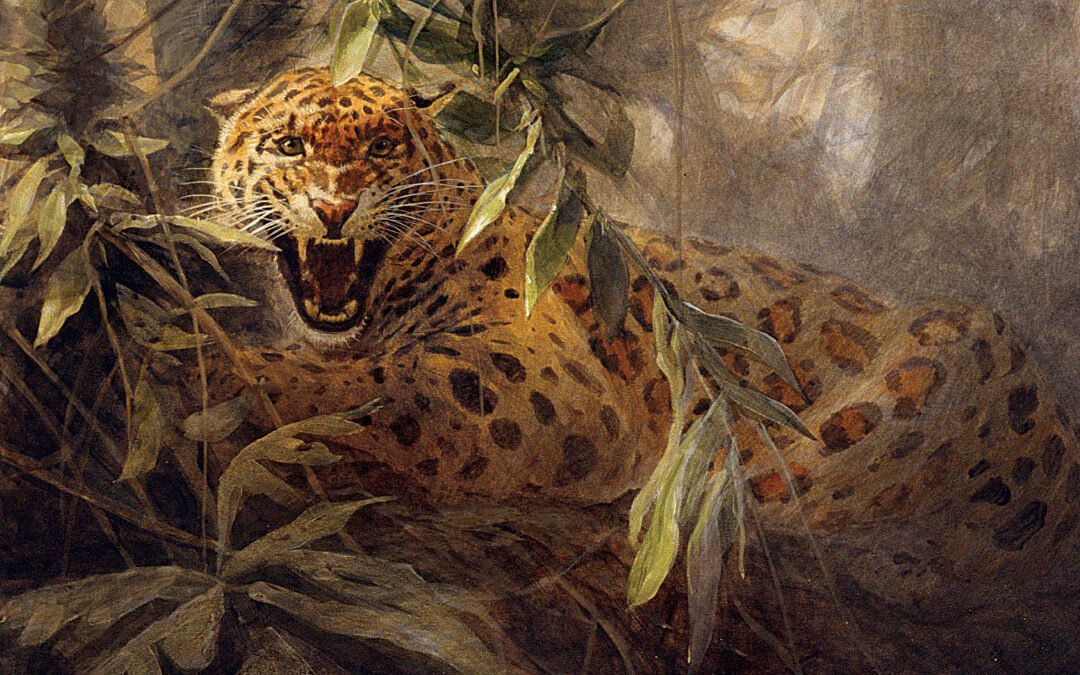On the day after Christmas in 1913, Theodore Roosevelt and Kermit were planning another day of hunting on the Taquary River in Brazil. Both father and son were hunting jaguars before embarking on their big adventure down the River of Doubt.
The jaguar is considered the lord of the South American jungle, just as the lion is the king of the African veldt. Back then it was certainly the most prized trophy for hunters in South and Central America.
Colonel Rondon, their expedition guide, explained that some of the big cats had been known to kill horses, goats, and cattle, but elsewhere they seemed to prefer the tapir. He noted that if a jaguar made a kill away from water, it would most likely drag its victim to water before eating. Heavy boned and extremely powerful, the big cats were capable of dragging a full-grown horse over a mile, as well as fighting and killing large anacondas.
The previous day TR had shot a large female jaguar. Now it was Kermit’s turn, and he was after a male for the museum’s collection. He would be using the same pack of hounds that his father used the previous day, but because the dogs had still not been fully tested in the field, Kermit was not confident in their ability to track and bay one of the big cats.
They headed out early and by ten o’clock, after a five-hour ride, the sun had forced its way through the morning mist. The party arrived at a deep, meandering bayou where the exhausted hounds were allowed to rest for a while. It was there that one of the Brazilian guides noticed some fresh jaguar tracks along the bank.
One of the older dogs had an all-black coat, which was not ideal for the stifling conditions. By the time they arrived at the bayou, the black dog looked as though it was almost done in from heat exhaustion, having been brought on a leash the entire way. Kermit drenched the dog with water, and soon it was refreshed enough to take notice of the tracks.
The old dog sniffed the pugmark while still lying down, then, after inhaling a healthy dose of the cat’s scent, he yelped loudly and seemed to start after the jaguar’s trail. He ran up and down the bank before finding a place where he could dive into the water, despite the presence of piranhas.
The hunters watched the hound’s actions and presumed the jaguar was not too far away. The men found a suitable place to cross the water, then one by one, with Kermit leading the way, they started wading the bayou with the main pack of dogs paddling behind them. The crossing was made even more difficult because of the thick tangle of aquatic plants and the reluctance of the short-legged horses to venture too deep.
Kermit showed good horsemanship when he forced his mount through the tangled mass. The little horse plunged into the marshy soup, creating a path that made it easier for the other horses to follow.
Reaching the other side of the marsh, the hunters emerged in a thicket of tall trees and low-growing palms with long fronds carrying heavy clusters of nuts. By the time the horsemen rode through the woods, the dogs had already passed them and could be heard in the distance.
The men rode as hard as possible whenever the dogs’ yelping and barking seemed to indicate that the big cat might be treed. Their frenzied yaps, yelps, and barks, along with the shouts of the Brazilian horsemen, echoed through the jungle.
As the dogs crowded in on their quarry, their baying grew louder and the thrill of the chase grew even more exciting among the horsemen. They knew the cat was at bay, but was it in a tree or on the ground? The latter could be dangerous. The cat might charge, and they would probably only have one chance to stop it.
As the men rode into a clearing, they could see the jaguar in the branches of a large fig tree. It was a big male. As they drew nearer, the cat eyed the hunters, ready to leap away and race off into the woods. But before he could make his escape, Kermit fired his .405 Winchester, dropping the cat to the ground.
The jaguar was one of the biggest cats the Roosevelts had ever encountered, in Africa or the Americas. It was heavily muscled with big bones and a stout frame, nothing like the sleek and slender leopard or mountain lion.
The men were in awe of its beautiful, satiny pelt, with large dark-brown rosettes emblazoned on its golden coat. Its markings were very distinctive and easily identifiable to some ranch hands who recognized the jaguar as the same cat that had killed some cattle in the area. Apparently they had been pursuing the cattle-killer for some time.
On one occasion hunters and ranch hands had actually cornered the jaguar, but he had escaped at the last moment. He then returned to kill livestock at irregular intervals. The cat had also been seen in the marshes as it searched for prey.
Jaguars are very capable of killing wild animals such as deer, tapirs, capybaras, peccaries, and even big Caymans. But in that area they seemed to prefer horses and cattle.
So it seemed that Kermit had done the ranchers a big favor, while at the same time bagging a splendid male specimen for the museum.
This story is among 60 chapters in John Seerey-Lester’s The Legendary Hunts of Theodore Roosevelt. The 200-page book features more than 150 paintings and sketches. Order your copy today!

